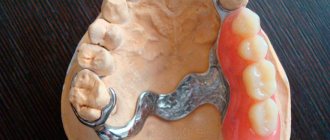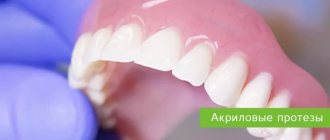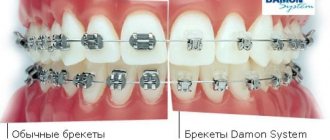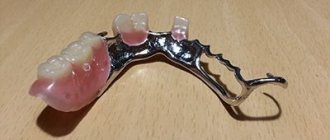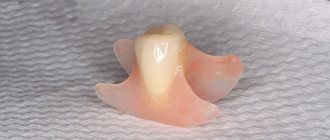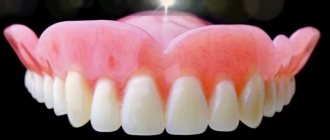Until recently, people who used removable dentures had problems securing the product in the oral cavity. Modern dentistry has many ways to restore chewing functions and the beauty of a smile. The clasp prosthesis received good recommendations from specialists. It is securely fixed on supporting teeth and crowns, allowing a person to feel comfortable and confident.
Depending on the method of creation, prostheses can be precision (made in a factory) or semi-precision (made in a laboratory based on modeling casts). Products have several types of fastening, which have their own advantages and disadvantages.
Clasp design
Such support-retaining mechanisms, which are extensions from the base of the prosthesis, are most often made of metal. This allows you to chew food efficiently and painlessly. The upper clasp fastenings do not affect diction and do not dull the sensitivity of taste buds located on the palate. The design, despite its simple structure, copes with restoring the function of chewing food better than nylon or plastic counterparts.
Design with metal clasps
Due to the destructive effect of metal on enamel, it is recommended to first install abrasion-resistant crowns on the abutment teeth.
The outer part of the clasp is visible on the surface of the teeth, but if the aesthetics of a smile is important to the patient, then the front clasps can be made of invisible polymer materials.
Polymer clasps
Patient reviews
Konstantin, Moscow. I used partially removable dental structures for 2 years until the need for prosthetics arose. Every person who wants to preserve the beauty of their teeth eventually faces the procedure. The doctor installed the bulge prosthesis for 3 weeks. There was no pain when installing the structures, since there was no need to grind the supporting units. I wear a denture and don’t notice that it’s in my mouth. I didn't have any adjustment period at all. The doctor allowed me to consume familiar foods (including those with dyes). I only excluded toffees and chewing candies from my diet.
Artemy, Samara. The dentist advised me to install a bulge denture on the lower jaw after I lost 1 molar. The doctor said that this particular design would be optimal in my case, since it would prevent premature loosening of neighboring elements. I have been wearing a plastic device for 3 years and can only note one drawback - the need to get used to the material. The adaptation period took 3-4 weeks. After that everything returned to normal.
Sergey, Tver. I did not appreciate the advantages of the design. The bulge denture did not hold well in the oral cavity and constantly moved when speaking. It was difficult to chew rough food and bite off large pieces of fruits and vegetables. I have been wearing the design for 1 month and hope that I will get used to it in the near future. I had to refuse implants due to the structural features of the jaw structures.
Tatyana, Orel. I wanted to restore my lower chewing teeth using bulge dentures. It took me about 1 month to get used to the new designs and even went to bed with them. The doctor dissuaded me from installing the consoles, citing the possible loosening of adjacent teeth. I noted the convenience of the system and the almost complete absence of discomfort when chewing food. The denture is simply removed and placed back in the mouth. Caring for it also does not cause much trouble.
Attachment option (lock fastening)
One of the parts of the micro-lock (attachment) is located on the teeth enclosed in metal-ceramic crowns, and the second is on the clasp prosthesis. The mechanism snaps into place and provides a secure fit.
According to the method of fastening, locks are divided into the following types:
- intra-root, which are held on root caps;
- placed inside the product;
- soldered to the surface of the implant.
Before installing the prosthesis, the specialist cleans the enamel using ultrasound. It is important to cure all pathological phenomena in the oral cavity. A mandatory step is the installation of at least four crowns on the treated and ground abutment teeth. After completing the procedures, the structure is placed on the surface of the jaw.
Lock fastenings have a number of advantages - they are practically invisible, comfortable, and last 5-7 years or more. The design is considered high-tech and requires highly qualified specialists, but is not visible to others.
There are several types of attachments:
- hinged - joint;
- labile - shifting in any plane;
- crossbar - having a small valve;
- anchor - linked by a sphere or a button;
- semi-labile - capable of moving vertically;
- beams - a thin rod between the crowns that fits into the groove on the bottom of the prosthesis.
The choice of prosthesis is made by an orthopedist, focusing on the needs of the patient. The main mechanical impact in a design with a rigid connection is transmitted to the abutment teeth taken under the crowns. In a softer version, the load is evenly distributed over the entire jaw.
According to the level of rigidity, attachments are divided into three types:
- the toughest ones are red;
- medium hard - yellow;
- soft - green.
The locking mechanism quickly weakens, and the locking elements may need to be replaced every year and a half. The cost of repairs is about 100 rubles. The orthopedist removes worn parts and immediately installs new ones.
Advantages and disadvantages
Clasp dentures are used very often. This is due to the fact that their installation does not require much time, and the procedure itself does not have many contraindications. In addition, after such prosthetics, the patient practically does not feel any discomfort - his diction does not change, he can easily eat all the food he is accustomed to. In the first days after installation of the prosthesis, a slight pressure may be felt, since the presence of a foreign body in the mouth will be unusual. However, within a week all such sensations will pass.
Another advantage of clasp dentures is their durability. It is these structures that are the most durable compared to any other prostheses. This applies to both mechanical effects on them and physical or chemical ones. This type of structure can be worn around the clock; it will remain stably in a given position.
But the main advantage of this type of prosthesis is that it completely preserves the aesthetic appearance of the dentition. During the procedure, the specialist will select the design option that will fully match the color and shape of the patient’s natural teeth. Thus, people around you will not notice the presence of an artificial element in your mouth at all.
As for the disadvantages of clasp dentures, they include the following:
- quite high price, which is compensated by a long period of use;
- mandatory presence of supporting teeth to fix the structure;
- temporary discomfort in the first days after installation, which soon disappears completely.
The last of the minuses is quite insignificant, given that after a few days a person will absolutely not notice the presence of a prosthesis and will be able to lead his usual lifestyle, enjoying his smile.
On telescopic crowns
This method of prosthetics is very common abroad. The supporting teeth are ground down, then metal caps are attached to them using cement. Two crowns are placed on the prosthesis frame. When put on, they are inserted on top of the caps.
The design is invisible during a conversation, evenly distributes the chewing load and is well fixed. This is the most expensive design to install.
Indications and contraindications for installation
The possibility of installing a clasp is determined during a dental examination. Removable dentures are used in the following cases:
- some molars are missing;
- it is necessary to hide multiple dental defects;
- The patient has been diagnosed with diabetes mellitus and periodontal disease;
- prominent maxillary cusps;
- flat sky;
- pathological weakness of gum capillaries;
- broken bite;
- atrophy of the alveolar processes;
- there is no possibility to install a fixed prosthesis, for example, due to severe inclination of the teeth;
- bruxism (teeth grinding);
- enamel wear is observed;
- it is necessary to restore the aesthetics of the anterior dentition.
The peculiarities of the clasps do not allow them to be installed on damaged abutment teeth affected by caries. There are other contraindications:
- small lingual-buccal space;
- inflammatory process in the area of the roots of supporting teeth;
- periodontitis;
- Lowered crowns were previously installed.
Subtleties of care
In order to extend the service life of a clasp prosthesis with locks, it is necessary to comply with the conditions of its operation. It is enough to follow simple rules:
- After each meal, rinse the structure with clean boiled water.
- Clean the denture twice a day using a toothbrush and paste, as well as a special antiseptic solution.
- Visit your dentist regularly for professional cleanings and preventive examinations.
- Avoid too hot food and drinks, chemical and mechanical effects on the prosthesis.
- If necessary, make timely repairs and corrections.
Disadvantages of clasp dentures with locks
But with all the advantages of clasp dentures with locks, you should keep in mind some of their disadvantages. The most important thing is the high cost of this product, since it requires the use of expensive materials, labor-intensive work of three specialists and the use of unique equipment during production. In this case, it is highly desirable that the prosthesis fits after the first fitting and does not need modification. If the measurements are taken incorrectly, it may happen that it becomes necessary to start all over again.
Another disadvantage is the need for mandatory treatment of the supporting teeth, which will no longer be possible to return to their original appearance, especially if they are initially healthy. In some cases, tooth depulpation may be required. In addition, it is not a fact that the teeth will meet the necessary conditions for the installation of attachments.
Despite the positive aspect of a long service life, clasp fastenings will need periodic replacement, since with this method of fastening the load is carried only on the supporting teeth, while with clasp fastening it is evenly distributed on the soft tissues of the mucous membrane.
When wearing a clasp denture, the process of bone atrophy under the dentures is inevitable. The chewing process contributes to the constant pressure of the structure on the site of missing teeth, which is why voids begin to form, which from time to time need to be filled by applying additional plastic to the prosthesis. However, it should be added that it is much worse if there is no load at all on the periosteum, devoid of teeth, in which case bone atrophy occurs much earlier. So the presence of a clasp prosthesis in such a situation will be preferable to its absence.
A clasp prosthesis with a locking fastening is easy to use and does not require special skills in handling it. You can clean the denture under running water with a brush using special products to prevent plaque or food from accumulating under them. There is no particular need to remove it at night and keep it in a certain place, although sometimes dentists advise sticking to this rule so as not to put constant stress on the mucous membrane. If you follow these simple rules for caring for your prosthesis, it will last more than 5 years.
Leading manufacturers and cost
One of the best laboratories specializing in the manufacture of clasps is AlvaDent. The company is located on the territory of the Russian Federation; Swiss equipment is used for production, guaranteeing product quality.
Ball-shaped fasteners used for fixing clasp dentures on attachments are produced by the Italian concern Rhein-83 and the German company Bredent.
The company CENDRES & METAUX SA DENTAL, located in Switzerland, produces hinged and locking fasteners. An improved locking system was developed here, including 6 types of lock mechanism matrix and one patrix. From this organization you can order semi-labile, labile, beam and rigid spherical attachments.
The price of clasp dentures starts from 45 thousand rubles and depends on the type of product being installed, the clinic and the condition of the patient’s teeth.
Price
How much does a bulge denture cost? The price of the structure depends on the type of fastening, the material used and the policy of the dental clinic. The doctor selects the design for each patient individually, since for some, cheaper products may be more effective than expensive ones.
Average prices for installation of structures are presented in the table:
| Type of system depending on mounting | Price |
| splinting | 20-40 thousand rubles. |
| dentures with clasps | 15-20 thousand rubles. |
| one-sided prosthesis with locks | 35 thousand rubles. |
| Quadroti | from 28,000 thousand rubles. |
Most patients in their reviews discuss the lack of discomfort while wearing bulge constructions. They also note a short period of adaptation to a foreign object. Structures with clasps break more often than other types of prostheses, but they are replaced in a short time. You can read more patient reviews below.
Alternative options
Most orthopedists consider clasp dentures to be the optimal way to restore dentition. But at the request of the patient or existing indications, an alternative may be offered.
Nylon constructions or Acry-Free dentures:
Conditionally removable dentures fixed on several implants:
User reviews
Most patient reviews about clasp dentures are positive. But the quality of product installation always depends on the qualifications of the specialist.
I lost several teeth, and the clinic offered to install a denture with attachments. I was pleased with the result. Artificial teeth not only look great, but also do not cause discomfort.
Svetlana, 43 years old
I’ve been using a clasp prosthesis for three years and don’t take it off at night. The design is lightweight, with durable fastening. I was worried about the condition of the enamel, but there were no problems.
Mikhail, 52 years old
During the treatment of periodontal disease, I lost many teeth.
To return a beautiful smile, I decided to install a prosthesis. It was a little confusing that it was necessary to put crowns on healthy teeth, but the result is worth it. Elvira, 38 years old
What is clasp prosthetics?
The main feature of products of this type is the presence of a metal frame in the design, which connects a plastic base that imitates gums and artificial teeth.
A thin arc made of a special steel alloy has many advantages over a massive plastic jumper. It takes up less space in the mouth and increases the strength and reliability of the product. The likelihood of breakage of a removable clasp denture is minimal, since the rigid cast frame can withstand even high loads.
These products are more physiological for the oral cavity: when chewing, they load not only the gums, but also the teeth, as well as the jaw bone. This prevents the development of atrophic processes, which are inevitable when wearing flexible plastic structures of the new generation.
